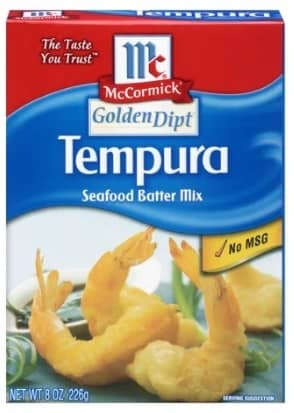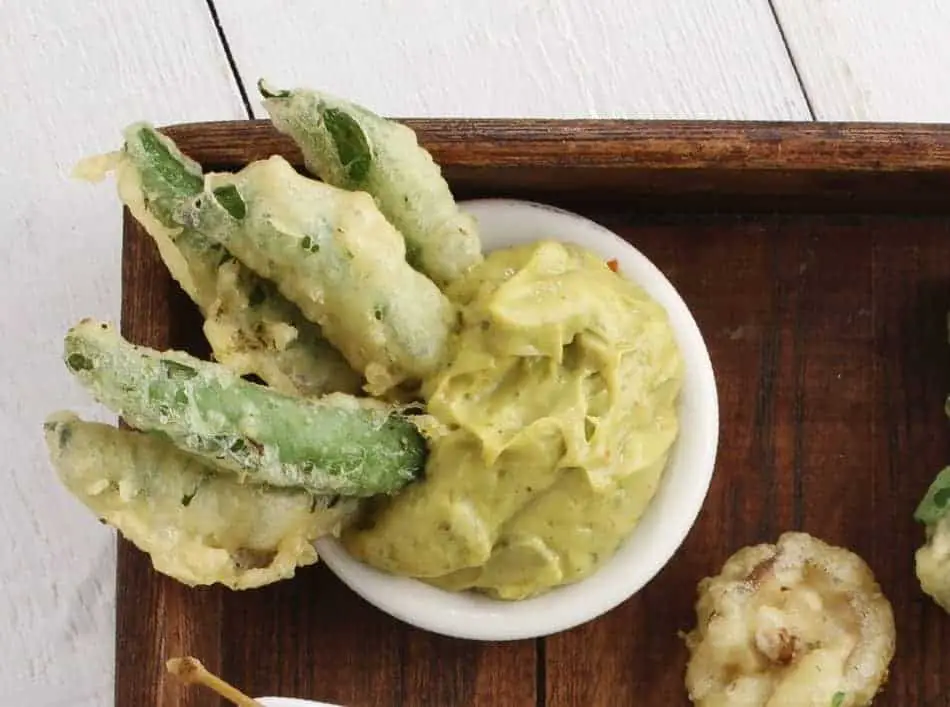Tempura is a popular Japanese appetizer wherein various foods are breaded and deep-fried. I used to consume tempura regularly when eating at Chinese buffets prior to becoming vegan. A lot of vegans and vegetarians grew up eating the tasty treat and want to know if they can continue to do so after switching to a plant-based diet.
Is it vegan or vegetarian? Tempura can be vegan if it’s the vegetable variety (as opposed to seafood or chicken) and the batter doesn’t contain eggs. Lacto-ovo vegetarians can consume vegetable tempura with eggs and/or milk in the batter.
Seafood tempura is never vegan but can be consumed by pescatarians—the subgroup of vegetarians who consume fish and seafood as a primary source of animal protein.
Finally, chicken tempura is off-limits for vegans and vegetarians. Pollotarians would be an exception, but pollotarianism tends to be thought of as a form of flexitarianism or semi-vegetarianism.
While tempura can be vegan, it’s best that you assume it isn’t until you’ve had an opportunity to vet the ingredients—on food panels if in a grocery store or on a website of a restaurant you plan to visit.
Animal Products Common in Tempura
Seafood
Wikipedia describes tempura as a dish consisting of seafood or vegetables that’s been battered and deep-fried.1
The most common seafood used for tempura is probably the shrimp variety known as ebi tempura.
Other types of seafood tempura include:1
- Prawn
- Squid
- Scallops
- Crabs
- Fish—catfish, white fish, salmon, cod, etc.
The list goes on, but that will give you an idea.
Poultry
Interesting to me is the name “tempura” which comes from the Latin phrase “quatnor anni tempora” that refers to the Ember Days, a time in which no meat is consumed.2
I would expect an appetizer with such a name to be limited to vegetables. Thankfully, vegetable tempura is as common, if not more so, than seafood tempura.
Plant foods commonly used in tempura include bamboo shoots, broccoli, bell pepper, butternut squash, eggplant, carrot, green beans, kabocha mushrooms, onion, okra, potato, pumpkin, and shiitake mushroom.1
An example of chicken tempura is Kahiki’s Crispy Tempura Sweet & Sour Chicken.
It contains:3
- Chicken white meat
- Wheat flour, cornstarch, potato starch
- Salt, Water, Baking Soda
- Wine vinegar
- Vegetable oil
- Yeast extract
- Eggs
- Spices
- Soy sauce (water, soybeans, wheat, salt, and alcohol)
- Honey, pineapple juice concentrate
- Xanthan gum
- Aged cayenne red peppers
- Garlic powder, garlic, ginger, paprika extracts
- Natural flavor
There’s also the tempura-battered chicken you’ll encounter in Asian restaurants. It’s a thicker and more uniform batter, so I think less of tempura and more of chicken nuggets when I see these.
Anyway, that’s just one more example of a non-vegan and non-vegetarian form of tempura.
Eggs
Eggs have several useful functions in food production, and binding is one of them. Tempura is breaded and fried. The batter preparation doesn’t leave much time for the formation of gluten, which is the protein naturally present in wheat flour that helps ingredients in bread products adhere.
Also, batters differ from dough in that they have a high water content which is bad for gluten development.
Eggs are added to the batter in order to provide another protein source to hold ingredients together.
In tempura preparation, the vegetables are dipped directly into a batter containing egg, or dipped in an egg wash and rolled around in flour.4
When it cooks, the high heat coagulates the egg protein, binding all of the ingredients together.4
I have seen tempura recipes that didn’t call for eggs, but they’re few and far between.
Cold water and light flour are the two main ingredients—the two ingredients that are always present—while eggs are commonly, but not always, added to the mix.1,5-7
Milk is always a possibility ingredient when it comes to batter. If you’re a connoisseur of fried foods, as I was prior to becoming vegan, you probably noticed that not all fried foods have the same consistency. Some have a nice uniform, bread-like texture, while others have a flakier and crumblier texture.
This can be due to a number of reasons, including the presence of egg, milk, or the method in which the batter is mixed (i.e. the amount of gluten that’s allowed to form).
I’ve yet to run across milk in tempura batter, but it wouldn’t surprise me if a commercial mix contained milk or dairy derivatives. So, that’s just one more thing to look out for.
Commercial Vegan Tempura

I was, unfortunately, unable to find any vegetable tempura, but there are several tempura batter mixes on the market that are animal product free.
For example, McCormick’s Golden Dipt Tempura Seafood Batter Mix contains:8
- Enriched wheat flour (flour, niacin, iron, thiamine mononitrate, riboflavin, and folic acid)
- Rice flour
- Corn starch
- Leavening agents (sodium acid pyrophosphate, sodium bicarbonate, and monocalcium phosphate)
Alternatively, you can make your own. Just purchase your favorite frozen vegetables and dip them in a homemade egg-free batter. A soft wheat flour (e.g. cake or pastry flour) works best.
You’ll also want to make sure to use a vegan-friendly dipping sauce.
Vegan-friendly tempura sauces usually contain ingredients like tamari or soy sauce, maple syrup, vinegar, plant oils (e.g. sesame or sunflower), and sliced onion.
That’s it for the vegan status of tempura. Thanks for reading.
You may also want to check out the following related articles:
References
- Tempura. https://en.wikipedia.org/wiki/Tempura
- Travel – The Truth About Japanese Tempura. David Farley – http://www.bbc.com/travel/story/20170808-the-truth-about-japanese-tempura
- Kahiki® Crispy Tempura Sweet & Sour Chicken, 24 oz. https://www.walmart.com/ip/Kahiki-Crispy-Tempura-Sweet-Sour-Chicken-24-oz/45127039
- Understanding Food: Principles and Preparation (Page 256). Amy Brown – Wadsworth Cengage Learning – 2011
- Okamoto, Osamu (1994). Sam Okamoto’s incredible vegetables. Pelican Publishing Company. p. 31. ISBN 1-56554-025-5.
- Meyer, Arthur L.; Vann, Jon M. (2003). The Appetizer Atlas: A World of Small Bites. John Wiley and Sons. p. 235. ISBN 0-471-41102-7.
- Kobayashi, Katsuyo (2000). The quick and easy Japanese cookbook: great recipes from Japan’s favorite TV cooking show host. Kodansha International. p. 23. ISBN 4-7700-2504-1.
- (4 Pack) McCormick Golden Dipt Tempura Seafood Batter Mix, 8 oz. https://www.walmart.com/ip/4-Pack-McCormick-Golden-Dipt-Tempura-Seafood-Batter-Mix-8-oz/47237463

